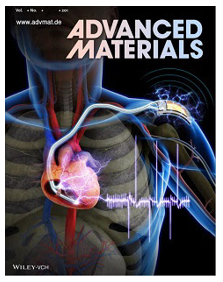Highlight
| Intro | Collaborative research team led by Prof. Keon Jae Lee from KAIST and Prof. Joung from Severance Hospital of Yonsei University has recently developed the world’s first artificial cardiac pacemaker semi-permanently operated by self-powered flexible piezoelectric nanogenerator. The artificial cardiac pacemaker is widely acknowledged as medical equipment that integrated in a human body for regulating the beating of heart through electrical stimulation while contracting the cardiac muscle of people who suffer from an abnormal heart rate. The high-performance flexible nanogenerator was made of single crystal PMN-PT thin film (iBULe Photonics Co., Ltd.), and the harvested energy could be reached at the level of 8.2 V and 0.22 mA just by simple bending and pushing, which was enough to directly stimulate living heart of rat. In addition, the flexible piezoelectric nanogenerator could be utilized as an electric energy source for various implantable medical devices. |
|---|---|
| Principal Investigator | Keon Jae Lee |
| Date | 2014-01-06 |

Collaborative research team led by Prof. Keon Jae Lee from KAIST and Prof. Joung from Severance Hospital of Yonsei University has recently developed the world’s first artificial cardiac pacemaker semi-permanently operated by self-powered flexible piezoelectric nanogenerator. The artificial cardiac pacemaker is widely acknowledged as medical equipment that integrated in a human body for regulating the beating of heart through electrical stimulation while contracting the cardiac muscle of people who suffer from an abnormal heart rate. The high-performance flexible nanogenerator was made of single crystal PMN-PT thin film (iBULe Photonics Co., Ltd.), and the harvested energy could be reached at the level of 8.2 V and 0.22 mA just by simple bending and pushing, which was enough to directly stimulate living heart of rat. In addition, the flexible piezoelectric nanogenerator could be utilized as an electric energy source for various implantable medical devices.






